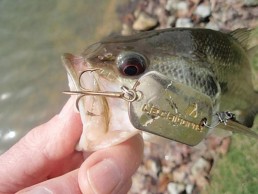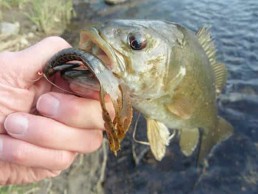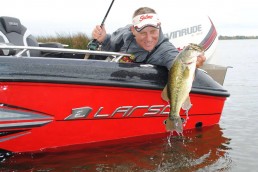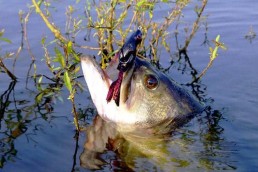Try Something Offbeat for Bass this Summer
SHARE THIS POST
At least 50 percent of my fishing time is spent in pursuit of both the largemouth and the smallmouth bass. My love affair with the species began in the 1960s, during the farm pond-building boom that seemed to sweep through the upper Midwest, stimulated by financial aid from the Soil Conservation Service. My dad put in two ponds and my brother-in-law added one more, all within several hundreds of yards of each other. This was pretty heady stuff for a young farm boy who liked to catch fish.
And catch them I did, on the standard fare for the time; Jitterbugs, Hula Poppers, Mepps Spinners, Rapalas and rubber worms. Nick Crème and Tom Mann revolutionized bass fishing with their Crème Wigglers and their Jelly Worms. Tons of bucket mouths have inhaled these soft worms and—more will be caught in the future—but it seems as though they have been absent at the latest and greatest of the bass fishing tournaments, being pushed aside by the latest and greatest of new lures to hit the market.
If you believe, as I do, that bass can become conditioned after seeing the same lures pass by their watery haunts year after year, then maybe it is time to break out of the mold and show them something new and unique.
Even though I have been bass fishing in excess of 50 years, I began to realize, decades ago, that catching them is only half the fun. The other half is comprised of a mixture of anticipation, planning, choosing the right lure, experiencing the thrill of victory or the agony of defeat, relishing the memories and then repeating the process.
Choosing the right lures is sometimes easy, sometimes frustrating, but it definitely is a challenge, and one that I eagerly embrace. There are few greater thrills in angling than catching a fish on a homemade lure. So, this year I constructed a few that are new and unique.
I may be the only person in the world who owns a Liz Claiborne lure. Several years ago, my good wife purchased a new purse with a 2×2-inch brass “Liz” insignia that was fastened to it by a key chain. Upon spying it, my devious mind automatically thought: fishing lure! Since it already had one hole in it, it was an easy matter to drill another and attach a split ring and a #6 treble hook. Voila, a new lure! Does it work? I’ll let the accompanying picture be the answer.
Being one to never throw anything away, I spied the handle of an old silver spoon gathering dust on my workbench. Once again, a light bulb went off and another lure was born. A friend used a drill press to poke two small holes in the very hard metal, a split ring was attached and a #6 Daiichi Bleeding Bait Hook was added. Why red? Good question! There are two prevailing theories. The first, according to T. J. Stallings, Director of Marketing and Crazy Ideas of T.T.I. Blakemore (ttiblakemore.com), says that red duplicates the gill flash of a wounded or fleeing bait fish and this in turn provokes an aggressive response from predatory fish. Makes sense to me.
Are you enjoying this post?
You can be among the first to get the latest info on where to go, what to use and how to use it!
The second thought is that red “disappears” in the water, and that since the fish can’t see it, the hooks do not spook them away from the lure. My thoughts go with the former theory. I think they can see the hooks, but the red color provokes them into striking. As pro walleye angler Mark Martin stated, “All I know is that I have cashed a lot more checks since I began putting Red Daiichi hooks on my Rapalas.”
At any rate, my new “spoon” works on bass, and I look forward to using it to jig up some walleyes through the ice on Saginaw Bay next winter. In the meantime “Ol’ Liz” is going to be sporting red hooks the next time she hits the water.
Road Runner lures, the little horsehead-shaped jigs that will catch any fish obviously can stand alone and bring the fish to the net, but I decided to customize one just for the fun of it. Once again, I found one on the workbench and let my imagination run free. For the past 10 years or so, I have had great success in catching bass on bubblegum pink artificial worms. So, I snipped off about 4-1/2 inches of an old, chewed up pink worm, attached it to the hook of a 1/8-ounce, red-headed Road Runner and set forth to try my luck. To my great happiness, the bass jumped all over it.
There are two small ponds within easy walking distance of my house that I like to think of as my “laboratories,” where I put my wacky ideas to the test. Consequently, on one early, chilly morning, I hiked back to the pond’s edge and began to cast. Within a short period I had landed eight largemouth that had (literally) inhaled my new lure. So much so, that I had to bite off about the first half inch of the worm and re-attach it. When the bass inhale a lure, rather than merely taking a swipe at it, this tells me that they like the look, action, smell, whatever, of the lure and want to eat it rather than just chase it out of the area.
If any of this appeals to you, do the same. Let your imagination be your guide, create something unique and build some memories of your own. Don’t forget to take some pictures.
MWO
SHARE THIS POST
Did you enjoy this post?
You can be among the first to get the latest info on where to go, what to use and how to use it!
John Bennett
John Bennett is a retired history teacher, historical re-enactor, father and grandfather. As a four-season outdoorsman, his passion is waterfowl hunting and fishing for smallmouth bass. He lives in Ohio and spends quite a bit of time in his primitive log cabin, which he built.




